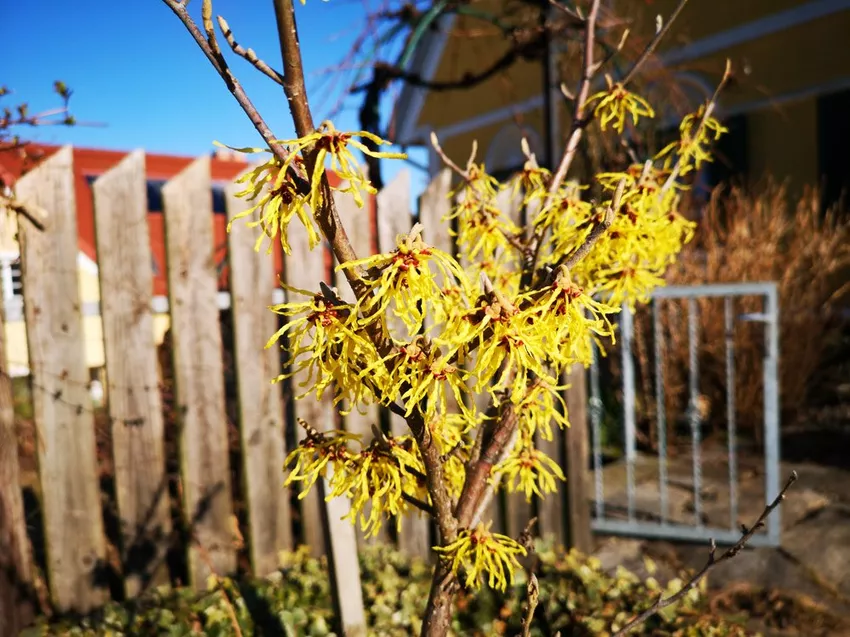The witch hazel is a real eye-catcher in winter gardens. It is represented by many different varieties. We present 4 of them to you.
 The witch hazel, also known by its botanical name witch hazel, impresses with delicate flowers in autumn and winter. A distinction is made between North American and East Asian species and hybrids of the two East Asian species.
The witch hazel, also known by its botanical name witch hazel, impresses with delicate flowers in autumn and winter. A distinction is made between North American and East Asian species and hybrids of the two East Asian species.
What they all have in common is that they beautify the cold season with delicate, colorful flowers.
Wild species of witch hazel from North America and East Asia
The Virginian witch hazel and the spring witch hazel are native to North America. Other species include the Japanese and Chinese witch hazel.
The two plants from East Asia are more popular in the garden because the flowers are larger and the flowering times are longer. The flowering phase begins in December and lasts until the end of March. Numerous hybrids have emerged from the East Asian witch hazel bushes.
Flower splendor in the winter garden: witch hazel from yellow to dark red
In spring and summer, witch hazel can hardly be distinguished from hazelnuts. However, the two plants belong to different genera and have nothing in common apart from the similar name and partly the shape of the leaves. The witch hazel sheds its leaves in autumn. But then - as if by magic - the flowering phase begins in early winter.
Proven types of witch hazel for the garden
Witch Hazel 'Pallida'

| Hammamelis intermedia 'Pallida') | |
|---|---|
| Growth Speed: | 15 - 40 cm a year |
| Growth: | 250 - 300 cm |
| Growth: | 150 - 300 cm |
| Root system: | Shallow roots |
| Location: | Sun to partial shade |
| Floor: | fresh to moist, humic, well-drained, slightly acidic to acidic |
The witch hazel 'Pallida' begins to bloom at Christmas time. It has quite large, sulphur-yellow flowers and is therefore easy to recognize from afar. The flowers smell intense.
Witch Hazel 'Primavera'

| Couple nut 'Primavera' (Hamamelis intermedia 'Primavera') | |
|---|---|
| Growth Speed: | 15 - 25 cm a year |
| Growth: | 250 - 350 cm |
| Growth: | 150 - 200 cm |
| Root system: | Shallow roots |
| Location: | Sun to partial shade |
| Floor: | fresh, moist, permeable, sour, humic |
The witch hazel 'Primavera' is also one of the early flowering types of witch hazel. It is floriferous and provides a spring-like sight in the garden with medium-sized, golden-yellow flowers. The petals are slightly ruffled.
Witch Hazel 'Jelena'

| Tobacco nut 'Jelena' (Hamamelis intermedia 'Jelena') | |
|---|---|
| Growth Speed: | 15 - 40 cm a year |
| Growth: | 200 - 300 cm |
| Growth: | 100 - 150 cm |
| Root system: | Shallow roots |
| Location: | Sun to partial shade |
| Floor: | fresh to moist, humic, well-drained, slightly acidic to acidic garden soil |
The witch hazel "Jelena" is also a beautiful eye-catcher when it is not in bloom. In autumn the leaves turn a gorgeous scarlet. When the witch hazel "Jelena" begins to bloom, the long petals, which become lighter towards the tip, are particularly impressive. The flowers shine in an intense orange-red.
Witch Hazel 'Diane'

| Cookie nut 'Diane' (Hamamelis intermedia 'Diane') | |
|---|---|
| Growth Speed: | 15 - 40 cm a year |
| Growth: | 200 - 300 cm |
| Growth: | 100 - 150 cm |
| Root system: | Shallow roots |
| Location: | Sun to partial shade |
| Floor: | fresh to moist, humic, well-drained, slightly acidic to acidic |
In February, the flowers of the witch hazel "Diane" open. With an intense shade of red, it completes the series of blossoms of the Hamamelis varieties. The foliage turns a warm orange-red in fall, but can also reach a rich scarlet red.
The right place for the witch hazel
Witch hazel bushes are very easy to care for. They can grow up to four meters tall over the years. That canhowever, take time. Witch hazel grows very slowly. A cut is not necessary.
The witch hazel prefers an airy, loose soil. The location, on the other hand, needs a little more attention. The plant is hardy, but: A sheltered location on the wall of the house promotes flowering. In mild winters, witch hazel blooms earlier, more abundantly and more persistently than in extremely frosty years with very low temperatures.
No magic: facts about witch hazel varieties
- Various hybrids of Chinese and Japanese witch hazel
- Winter flowering from December to March
- Loose soil and a sheltered location promote flowering
- Hardly a pruning necessary, easy to care for